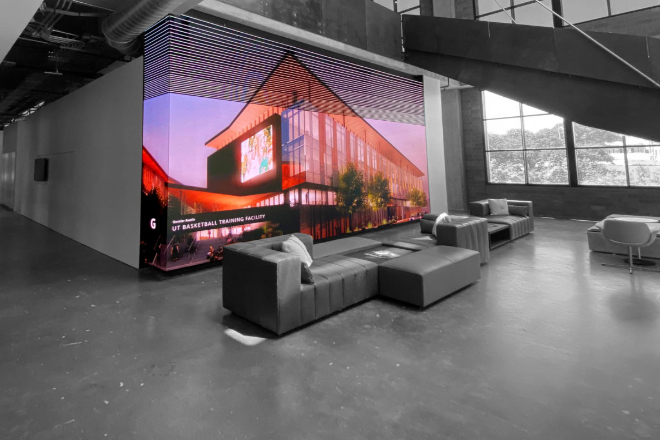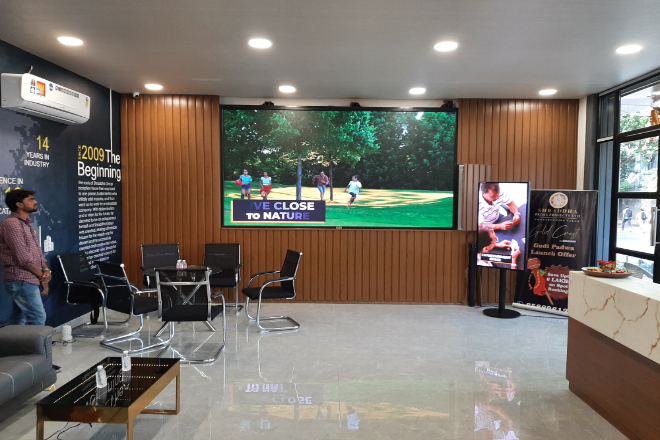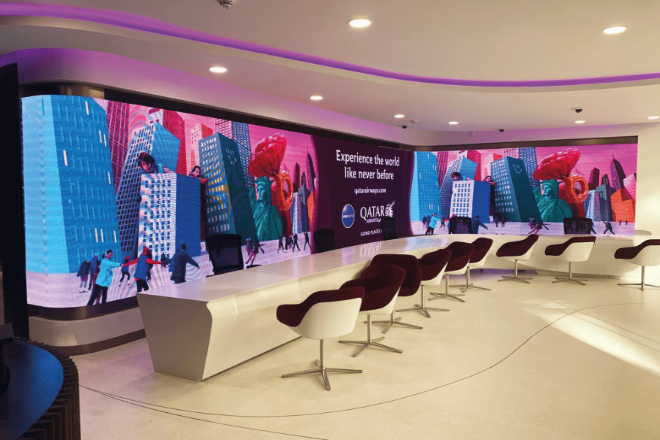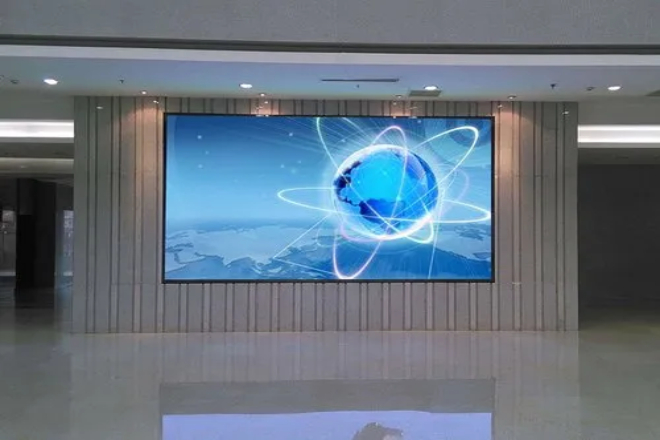소개
Are you worried about the display screen in the company’s reception room? Don’t worry, we have to talk about this. The reception room is an important place to display the company’s image and receive customers.
적당한 발광 다이오드 표시 스크린 can make your reception room instantly “high-end” and make customers feel full of sincerity. So, what are the main requirements for LED display screens in the company’s reception room?
목차
1. Analysis of reception room environment and functional requirements

1). Space size and layout
The size and layout of the reception room are the first things to consider when choosing a display screen.
In simple terms, you have to measure the area of the room, the height of the ceiling, and how far away everyone is from the screen after sitting down.
If the reception room is relatively small, such as an area of only 20 to 30 square meters, it is quite appropriate to put a medium-sized display screen, such as a 40 to 50-inch one, so that everyone can see it clearly when sitting more than two meters away.
If the room is larger, with an area of 50 to 60 square meters or even larger, then the screen must be larger, such as 50 to 70 inches, or even larger, otherwise the people sitting in the back will not be able to see clearly.
The height of the room is also very important. Generally speaking, the height of the reception room is about 2.5 meters to 3.5 meters. If the room is relatively high, it will be more imposing, and the visual effect will be better if a large screen is placed there.
Reasonable arrangement of the position and size of the screen can not only ensure that everyone can watch comfortably but also make the entire reception room look more coordinated and easier to use.
2). Main purpose
What the reception room is mainly used for determines what functions the display screen must have.
For example, if it is mainly used for business negotiations, the screen resolution must be at least full HD (1920×1080) so that text and graphics can be displayed clearly.
The screen ratio should preferably be 16:9 because most documents and presentation software are in this ratio.
Moreover, it is best to support wireless projection and multi-screen interaction so that everyone can easily share the content on the mobile phone or computer to the screen.
If the reception room is used to display products, the screen 해결 must be higher. 4K (3840×2160) is very good and can clearly display the details of the product.
The screen ratio can also be selected according to the product characteristics. For example, if the displayed product is relatively long, a 21:9 ultra-wide screen may be more suitable.
In addition, it is important to support touch operation and multi-window display so that everyone can understand the product more intuitively.
If the reception room is mainly used for large-scale meetings, the screen resolution must be at least full HD. If complex data is to be displayed, 4K is more advantageous.
Moreover, it is best to support multiple people operating at the same time (such as using it as an electronic whiteboard), remote conference access, and linkage with other screens, so as to meet the needs of large-scale meetings and make meetings more efficient.
3). Light conditions
Light conditions have a great impact on the display effect of the display. First of all, you have to look at the natural light in the reception room.
For example, if the room faces south, the sunlight may be very dazzling, so it is best to install blackout curtains or blinds, otherwise the content on the screen will be blurred by the sunlight.
Indoor lighting is also critical. If it is used for business negotiations, the light can be adjusted softly, and the screen brightness is about 300 to 500 nits.
But if you want to display products or the room is bright, the screen brightness must be higher, such as 500 to 800 nits so that the product details can be more prominent. Contrast is also very important.
In dark places, a lower contrast can also be seen clearly.
But in bright places, the contrast must be at least 1000:1, otherwise the picture on the screen will appear gray.
The lighting design is also very particular. Try not to let the light shine directly on the screen. It is best to use soft indirect lighting, which can reduce reflections and allow everyone to see clearly under various lighting conditions.
2. Selection of LED display types in the reception room
Choosing an LED display in the reception room is like choosing clothes. It depends on the occasion and needs. Generally speaking, there are three common types to choose from: indoor LED display, spliced screen and integrated screen.
1). 실내 LED 디스플레이
The indoor LED display is like a “versatile style”. It is particularly suitable for indoor environments such as reception rooms, with clear picture quality and bright colors, and can present very delicate picture effects.
For example, the small-pitch LED display has a high resolution and looks very comfortable. It can also automatically adjust the brightness according to the ambient light and will not be dazzling.
This display is particularly suitable for high-end reception rooms and can make your reception room look very classy.
2). Splicing screen
The splicing screen is like a “Lego building block” and can be flexibly combined according to the size and shape of the reception room.
If your reception room space is limited or the budget is not very generous, the splicing screen is a very affordable choice.
However, there is a small disadvantage of the splicing screen, that is, there may be gaps between the screens, which looks a bit like a puzzle and is not very coherent.
But if the overall requirements for the picture are not so high, the splicing screen can fully meet the needs, and the size of the screen can be adjusted at any time according to needs.
3). Integrated screen
The integrated screen is the kind of “high-end customized model” with no splicing gaps, and the picture looks particularly complete.
This type of screen is usually larger in size and has a fixed installation location. It is suitable for reception rooms that have high requirements for display effects and have sufficient space and budget.
If you want your reception room to look particularly high-end, an integrated screen is definitely a plus.
In general, if your reception room is not large and has a limited budget, a spliced screen is a good choice.
If you have high requirements for the picture effect and are not short of money, an integrated screen will be a better choice。
And the indoor LED display is between the two, which is both beautiful and practical, suitable for most reception rooms.
Requirement 1: Requirements for the resolution and image quality of LED display screens

1). The importance of high 해결
First of all, a high-resolution LED display screen is like a pair of high-definition glasses that can see the picture clearly.
If you are showing complex charts, such as dense data analysis charts or high-definition pictures and videos, a high-resolution screen can show all these details without blurring.
For example, the 4K resolution (3840×2160) screen has double the clarity compared to the ordinary full HD (1920×1080) screen, which looks very comfortable.
This kind of screen can make you look very professional when displaying company products or important projects so that customers can see your intentions at a glance.
2). Color reproduction and contrast
Color reproduction and contrast are also critical. A screen with good color reproduction can restore colors very realistically, such as red looks bright red, not orange or purple.
A screen with high contrast can make the picture more layered.
For example, when displaying company logos or product pictures, high contrast can make colors more vivid, black and white contrast more obvious, and the picture more three-dimensional.
If the contrast is low, the picture will appear gray and there will be no “wow” feeling.
Therefore, choosing a screen with good color reproduction and high contrast can not only make your display content more attractive but also enhance your brand image so that customers will think you are very professional and attentive.
Requirement 2: For the brightness and energy-saving characteristics of LED display
1). 명도 adjustment function
Imagine that the reception room has sunlight pouring in during the day and only indoor lights at night. If the screen brightness is fixed, it will be uncomfortable.
If it is too bright, the eyes will be uncomfortable; if it is too dark, it will be unclear.
Therefore, the brightness adjustment function is particularly important. A good LED display can adjust the brightness automatically or manually, just like installing a “smart dimming lamp” on the screen.
For example, when the light is strong during the day, the screen automatically brightens, and the picture is clear.
When the light is dark at night, the screen automatically dims, which looks comfortable and not dazzling.
Moreover, this adjustment function can also save electricity. After all, the screen consumes more electricity when it is bright and less electricity when it is dark.
2). Energy-saving characteristics
Why does the LED display save energy? Because it is like an efficient “little sun”. It can directly convert electrical energy into light energy, unlike old-fashioned light bulbs, which waste a lot of electricity on heating.
In addition, the LED display uses low-voltage electricity, which is more energy-saving and has a long life.
It does not need to be replaced for several years. Its cooling system is also very powerful, which can quickly take away excess heat and keep the screen “cool”, so that it will not waste electricity due to overheating.
In general, the LED display is like a smart and frugal “partner”. While giving you a good-looking picture, it can also help you save a lot of electricity bills.
Requirement 3: For the interactive function of the LED display

1). Touch function
If there are customers visiting the reception room, or if you want to show some product details, the touch function is particularly convenient.
Imagine that customers can directly slide on the screen, enlarge pictures, or click on videos with their hands. This feels like using a large tablet.
For example, when showing a new mobile phone, customers can operate it on the screen by themselves and see the various functions of the mobile phone. This kind of interactivity is much stronger than just saying “this phone is very good”.
Moreover, you can also mark the key points directly on the screen during the demonstration, and the explanation is more intuitive.
2). Wireless projection and network connection
The wireless projection function is simply a “lazy artifact”. In the past, when holding a meeting, everyone had to find wires all over the room and plug them in and out, which was very troublesome.
Now, with wireless projection, you can project the screen of your laptop or mobile phone directly onto the big screen easily.
For example, in a meeting, everyone can directly project the PPT onto the big screen without having to look for cables everywhere, which is much more efficient. Moreover, the network connection function is also very important.
For example, if you want to show the company’s latest data or online videos, you can directly call them up online without worrying about not bringing a USB drive or the files not being able to be transferred.
In this way, the display content can be updated at any time, and you can see whatever you want.
Requirement 4: Installation and maintenance of LED display screens
1). Installation method
Before installing the display screen, you have to look at the actual situation of the reception room. For example, if the wall of the reception room is relatively empty and the wall surface is flat, then the wall-mounted installation is very suitable.
This installation method not only allows the screen to be hung steadily on the wall, but also saves space and looks neat.
However, if the wall surface is not very flat, or you are worried that the wall surface is not load-bearing enough, the floor stand installation may be more suitable.
The floor stand is like a “small tripod” for the screen. The screen can stand steadily on the ground and can be moved as needed, which is very flexible.
In short, the installation method should be selected according to the specific situation of the reception room, which should ensure that the screen is installed firmly and not destroy the overall beauty of the reception room.
2). Maintenance convenience
A display screen that is easy to maintain and worry-free to use. For example, some display screens are modularly designed, which is like building blocks, and the screen is divided into small modules.
If a module has a problem, such as a broken lamp bead in a corner, you only need to replace that small module without replacing the entire screen. This can greatly reduce the cost and maintenance time.
In addition, it is also important to understand the warranty policy and after-sales service of the display screen.
Before purchasing, it is best to inquire about the after-sales service of this brand and whether there is a professional after-sales team.
If you encounter a problem, you can find professional technical support in time, and you will feel more at ease. After all, no one wants to have a problem with the screen at a critical moment and can’t find someone to repair it.
Requirement 5: Consideration of the brand and price of LED display screens

1). Brand selection
When buying a display screen, the brand is very important. A display screen of a well-known brand is like having a “quality guarantee”. These brands are usually more reliable in terms of product quality, performance stability, and after-sales service.
For example, some products from big brands rarely have problems when used, and even if there are problems, after-sales service can quickly help you solve them. Choosing a well-known brand may be slightly more expensive, but it can reduce a lot of worries and make you feel more at ease when using it.
Moreover, the display screens of well-known brands are also more advanced in technology, such as higher color reproduction and smarter brightness adjustment. These details can enhance your user experience.
2). Price factor
Of course, price is also critical. After all, every company has its own budget. On the premise of meeting the functional requirements of the reception room, it is better to choose a moderately priced display screen.
There is no need to blindly pursue high-end products. After all, the right one is the best. For example, if your reception room is mainly used for meetings and displaying some simple PPTs, there is no need to spend a lot of money to buy that kind of super high-end display screen.
But also be careful not to choose poor quality products just to save money. That kind of particularly cheap display screen may break down in a short time, and the repair cost may be higher than buying a better one at that time.
Therefore, the price and quality should be balanced, and choosing products with high cost performance is the best choice. You can compare several companies to see which product best meets your needs in terms of price and quality.
8. 결론
In short, choosing a suitable LED display is like tailoring a “coat” for the reception room. It not only improves the beauty of the space, but also makes every display and communication smoother.
I hope this article can help you find the “eye-catching” display and make the reception room the most eye-catching corner of the company.
마지막으로 LED 디스플레이에 대해 더 알고 싶으시다면, 우리에게 연락해주세요.
